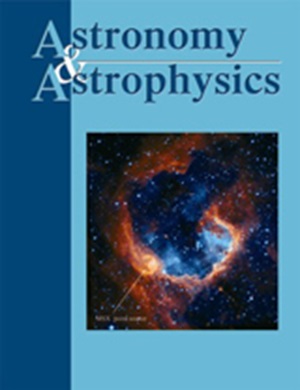CoRoT空间飞行任务中的凌日系外行星
IF 5.8
2区 物理与天体物理
引用次数: 0
摘要
目的。我们报告了利用 CoRoT 太空望远镜发现的两颗新的凌日巨型系外行星 CoRoT-30 b 和 CoRoT-31 b,以及它们的轨道和物理特征。我们分析了两组互补数据:CoRoT测量的测光凌日光变曲线和HARPS光谱仪测量的径向速度曲线。为了得出行星的绝对质量和半径,我们根据现有的星等和光谱对恒星进行了建模。我们发现,CoRoT-30 b 是一颗暖木星,围绕一颗半长轴约为 0.08 AU 的 G3V 恒星运行,轨道接近圆形,长 9.06 天。它的半径为 1.01 ± 0.08 RJ,质量为 2.90 ± 0.22 MJ,因此平均密度为 3.45 ± 0.65 g cm-3。热木星 CoRoT-31 b 围绕一颗半长轴约为 0.05 AU 的 G2 IV 恒星运行在一个近似圆形的 4.63 天轨道上。它的半径为 1.46 ± 0.30 RJ,质量为 0.84 ± 0.34 MJ,因此平均密度为 0.33 ± 0.18 g cm-3。这两个系统似乎都不支持寄宿行星的恒星锂消耗更多的说法。两颗行星的半径都接近木星,但它们的质量不同;CoRoT-30 b 的密度是 CoRoT-31 b 的十倍。CoRoT-30 b 的内核重量在 15 到 75 个地球质量之间,而相对较弱的约束条件表明 CoRoT-31 b 没有内核。CoRoT-31 b目前的角动量太小,行星无法朝着轨道旋转与恒星自转同步的方向演化,在其宿主恒星变为红巨星的同时,行星将缓慢旋入。CoRoT-30 b也不是同步的:由于恒星风的作用,它失去了角动量,预计将在大约2 Gyr后达到稳定状态。CoRoT-30和31作为一对,是热木星系统多样性的一个真正显著的例子。本文章由计算机程序翻译,如有差异,请以英文原文为准。
Transiting exoplanets from the CoRoT space mission
Aims. We report the discovery as well as the orbital and physical characterizations of two new transiting giant exoplanets, CoRoT-30 b and CoRoT-31 b, with the CoRoT space telescope.
Methods. We analyzed two complementary data sets: photometric transit light curves measured by CoRoT, and radial velocity curves measured by the HARPS spectrometer. To derive the absolute masses and radii of the planets, we modeled the stars from available magnitudes and spectra.
Results. We find that CoRoT-30 b is a warm Jupiter on a close-to-circular 9.06-day orbit around a G3V star with a semi-major axis of about 0.08 AU. It has a radius of 1.01 ± 0.08 RJ, a mass of 2.90 ± 0.22 MJ, and therefore a mean density of 3.45 ± 0.65 g cm−3. The hot Jupiter CoRoT-31 b is on a close-to-circular 4.63-day orbit around a G2 IV star with a semi-major axis of about 0.05 AU. It has a radius of 1.46 ± 0.30 RJ, a mass of 0.84 ± 0.34 MJ, and therefore a mean density of 0.33 ± 0.18 g cm−3.
Conclusions. Neither system seems to support the claim that stars hosting planets are more depleted in lithium. The radii of both planets are close to that of Jupiter, but they differ in mass; CoRoT-30 b is ten times denser than CoRoT-31 b. The core of CoRoT-30 b would weigh between 15 and 75 Earth masses, whereas relatively weak constraints favor no core for CoRoT-31 b. In terms of evolution, the characteristics of CoRoT-31 b appear to be compatible with the high-eccentricity migration scenario, which is not the case for CoRoT-30 b. The angular momentum of CoRoT-31 b is currently too low for the planet to evolve toward synchronization of its orbital revolution with stellar rotation, and the planet will slowly spiral-in while its host star becomes a red giant. CoRoT-30 b is not synchronized either: it looses angular momentum owing to stellar winds and is expected reach steady state in about 2 Gyr. CoRoT-30 and 31, as a pair, are a truly remarkable example of diversity in systems with hot Jupiters.
求助全文
通过发布文献求助,成功后即可免费获取论文全文。
去求助
来源期刊

Astronomy & Astrophysics
ASTRONOMY & ASTROPHYSICS-
自引率
27.70%
发文量
0
期刊介绍:
Astronomy & Astrophysics is an international Journal that publishes papers on all aspects of astronomy and astrophysics (theoretical, observational, and instrumental) independently of the techniques used to obtain the results.
 求助内容:
求助内容: 应助结果提醒方式:
应助结果提醒方式:


